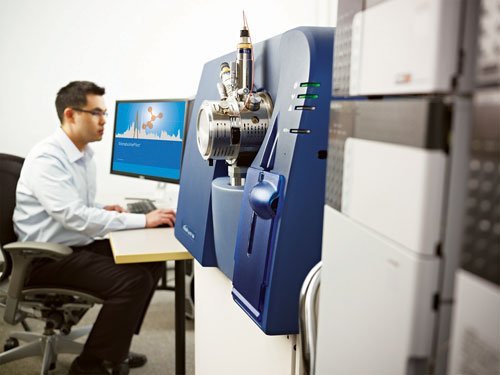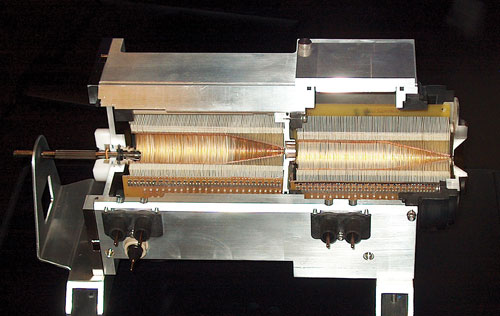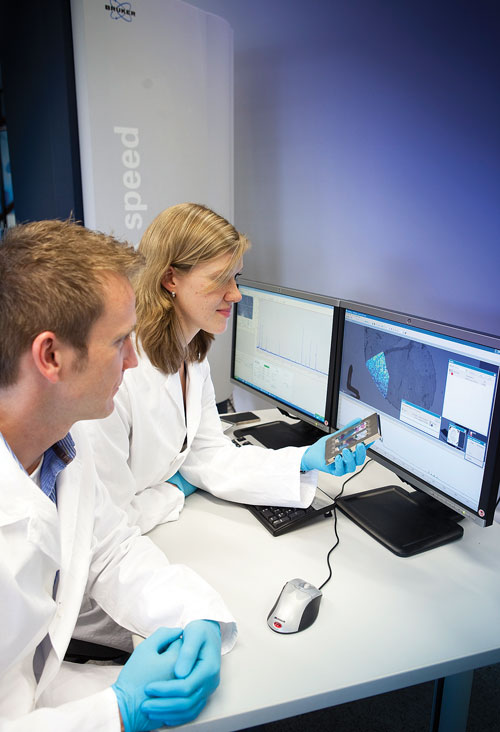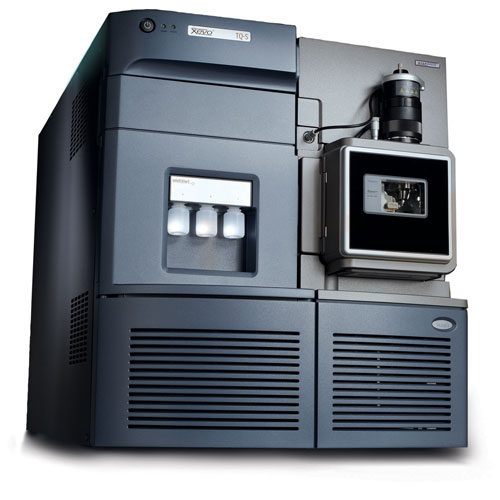September 1, 2010 (Vol. 30, No. 15)
A number of novel tools and technologies were showcased at the ASMS meeting. The highlighted instruments and software improve precision, speed, accuracy, and sensitivity.
> AB Sciex introduced the TripleTOF™ 5600 System, with features such as SmartSpeed™ with 100 Hz acquisition capability and 10 millisecond acquisition times; the Accelerator TOF Analyzer, in which the ion beam is pulsed into the TOF at 30 kHz, reflected to the bottom of the tube and then back to the top where the detector sits; and EasyMass™ Accuracy to ensure stable mass accuracy of about
1 ppm without continuous user calibration.
The 5600 system offers the quantitative capabilities of a triple quadrupole instrument using TOF technology, according to the company. The system can achieve more than 30,000 FWHM resolution across a range of speeds and offers a linear dynamic range of about four orders of magnitude.

AB Sciex reports that its TripleTOF™ 5600 System provides accurate mass at the speed and sensitivity of a triple quadrupole.
> Agilent Technologies highlighted its new 6490 Triple Quadrupole LC/MS System with iFunnel technology, which utilizes the company’s Jet Stream thermal gradient focusing technology to maximize the accessible gas-phase ions, which then enter the spectrometer through a six-capillary sampling array.
According to Agilent, the 6490 can detect molecules at the 10–21, or zeptomole, level. Agilent recently completed its acquisition of Varian, resulting in the addition of ion trap and FTMS technology to its MS portfolio.

According to Agilent Technologies, its iFunnel technology drives sensitivity gains in atmospheric pressure ion sampling for most applications. Agilent Jet Stream technology creates accessible gas-phase ions, which are drawn into the mass spec through a hexabore capillary sampling array. The ions are focused and separated from the gas by a dual-ion funnel assembly.
> In May, Bruker completed its acquisition of three product lines from Varian, which become part of the company’s new Bruker Chemical Analysis Division, a business unit of Bruker Daltonics.
Included in this deal, in which Agilent divested certain product lines as part of its deal to acquire Varian, are Varian’s gas chromatography (GC) instrument, GC triple-quadrupole MS system, and the inductively coupled plasma MS system.
At ASMS, Bruker launched a new product in its FLEX™ MALDI-TOF MS series, called the autoflex speed. It utilizes a 1 KHz smartbeam™-II laser, the company’s FlashDetector™ system, and a 4 GS/s digitizer. It offers a broad mass range, >26,000 FWHM resolving power at high throughput, and panoramic (PAN™) technology.
The MALDI Perpetual™ self-cleaning ion source reportedly cleans itself within 15 minutes without breaking the vacuum. Bruker also launched a MALDI source for the solariX™ FTMS. Its dual-ion funnel design allows for switching between MALDI and ESI ion sources.
Based on work with collaborating scientists, Bruker presented studies demonstrating the use of its maxis ETD QqTOF instrument to perform Edmass™ top-down sequencing of intact proteins of >60 kD molecular weight.

Bruker’s autoflex speed series incorporates the firm’s smartbeam-II laser technology, which combines the advantages of nitrogen lasers with the reliability of all-solid-state lasers.
> Waters introduced two new benchtop MS instruments to its Xevo MS platform, which can be integrated with the company’s Acquity® UltraPerformance LC (UPLC®) systems.
The Xevo TQ-S MS/MS system can measure target compounds at femtogram levels or less using quantitative UPLC/MRM technology. It incorporates StepWave™ ion-transfer technology to enhance ion-transfer efficiency and remove contaminants, as well as optics and collision cell features that enable simultaneous acquisition of MS and MRM data on 1–2 second wide peaks with >12 points/peak.
The new Xevo G2 QTof MS/MS instrument features the QuanTof™ technology found on the company’s Synapt G2 MS and G2 HDMS spectrometers.

The Xevo TQ-S is designed for UPLC/MS/MS applications such as biological and medical research, bioanalysis, environmental monitoring, and forensics testing. The system is capable of measuring target compounds in complex samples at femtogram levels or below, according to Waters.
> Shimadzu showcased the new LCMS-IT-TOF®, which according to the company, yields high-precision MSn data at high speed through a broad mass range. Technological features include compressed ion induction (CII™) in which the ion stream is converted into pulses before entry into the ion trap to control ion accumulation and pulses of argon gas that are delivered to the trap just prior to collision-induced dissociation (CID), maintaining product ion intensity as the CID energy increases.
The instrument also incorporates ballistic ion extraction, an ion acceleration method that helps lower the spatial distribution of the ions as they enter the TOF tube. The system can perform MS or MSn measurements and includes an auto MSn function for precursor ion selection.
> Thermo Fisher Scientific introduced MetQuest automated metabolic screening software for high-throughput drug metabolism screening on the company’s LTQ Orbitrap MS HRAM system or its Exactive family of LC/MS systems.
Thermo positioned the combination of the LTQ Orbitrap and MetQuest software as an alternative to triple quadrupole MRM technology, offering comparable precision, accuracy, linearity, and sensitivity, according to the company, and the capability to generate this data faster and more economically and without the need for MS/MS method development.
> PerkinElmer (PE) introduced the Flexar SQ 300 MS system, which is compatible with HPLC and UHPLC applications, incorporates a multi-stage ion path, and is controlled by PE’s new Chromera® software. The system has a mass range of 20–3,000 microns, a maximum scan rate of 10,000 microns/sec, and a resolution of
> Genedata featured its Expressionist® Refiner MS software at the meeting, a module of the Expressionist system that also includes Refiner Array, Refiner Genome, and Genedata Analyst™ and is designed for biomarker discovery and molecular-profiling applications.
Refiner MS automates raw data pre-processing across multiple MS formats based on user-designed workflows. The software corrects for high background levels, drift in retention time and m/z shifts, and allows for visualization, review, and annotation of the MS data for protein and metabolite identification.
> Covaris offers a range of sample-prep systems, including the E-series multisample ultrasonicator that applies focused acoustic energy to perform homogenization, tissue disruption, and sample extraction in 1 to 96 samples in one batch.
The S-series instrument performs single-tube sample prep, and the CryoPrep™ system employs a freeze-fracture technique, using dry cold processing to convert solid tissue samples such as tumor, bone, muscle, or skin into fine particles.
> Protea Biosciences showcased its Gel Protein Recovery (GPR®)-800 System, a microfluidic chip-based instrument for extracting proteins from polyacrylamide gels. Electroelution takes place simultaneously in eight parallel microchannels on the disposable chip to achieve protein extraction down to 100 ng. The GPR buffer contains a surfactant that simplifies sample degradation and cleanup in preparation for MS analysis.
> Nanoliter’s noncontact, parallel dried droplet dispensing technology deposits nanoliter-scale, concentrated, homogeneous drops to enhance sensitivity across a variety of MS applications. The company’s Nanoliter Wave induction-based fluidics (IBF) technology uses electric fields to launch, direct, and measure liquids in a nondispersive manner.
Studies comparing the IBF device to other approaches, such as micropipetting or use of a syringe pump, have demonstrated improvements in the signal-to-noise ratio, polymer spread, and signal intensity, and enhanced resolution for the preparation of MALDI plates.
> Pressure BioSciences developed the pressure-enhanced enzymatic proteolysis method based on its pressure-cycling technology (PCT). The company’s benchtop, automated Barocycler® NEP2320 performs rapid cycling of hydrostatic pressure from ambient to high pressure (up to 35,000 psi) to accelerate enzymatic digestion of proteins by as much as 10-fold.
Under high pressure, proteins will unfold, facilitating digestion. Both the NEP2320 and the larger NEP3229 utilize PULSE™ tubes to hold the sample. The tubes are submerged in distilled water in the reaction chamber of the Barocycler.
The PCT MicroTubes were designed for MS-based proteomic analysis; they are made of an inert fluoropolymer, with a chemically resistant, nonwetting surface to minimize sample adsorption.
> Hudson Surface Technology’s µFocus technology produces single-use, thin, stainless steel MALDI targets that contain hydrophilic regions on a hydrophobic surface to achieve concentrated deposition of samples in uniform matrix crystals.
> Protein Discovery recently introduced three new cartridge kits for its Gelfree™ 8100 Fractional System. The eight-channel fractionation cartridges are designed for different protein molecular weight ranges:
> Sage-N Research, a computational proteomics company, featured its Sorcerer proteomics platform for identifying and characterizing proteins in various disease states and for stem cell research.
Researchers can load MS spectral data in a variety of formats onto the Sorcerer platform, which performs protein identification and characterization of phospho-proteins and other post-translational modifications (PTM).
The SEQUEST 3G search engine can be used as a plug-in scoring module on the Sorcerer. It performs high-throughput spectrum matching, mass accuracy calculations, PTM enumeration, cross-correlation scoring of matches, ranking, and computation of scores, which can then be exported or utilized on the Sorcerer platform.

Pressure BioSciences’ Barocycler



